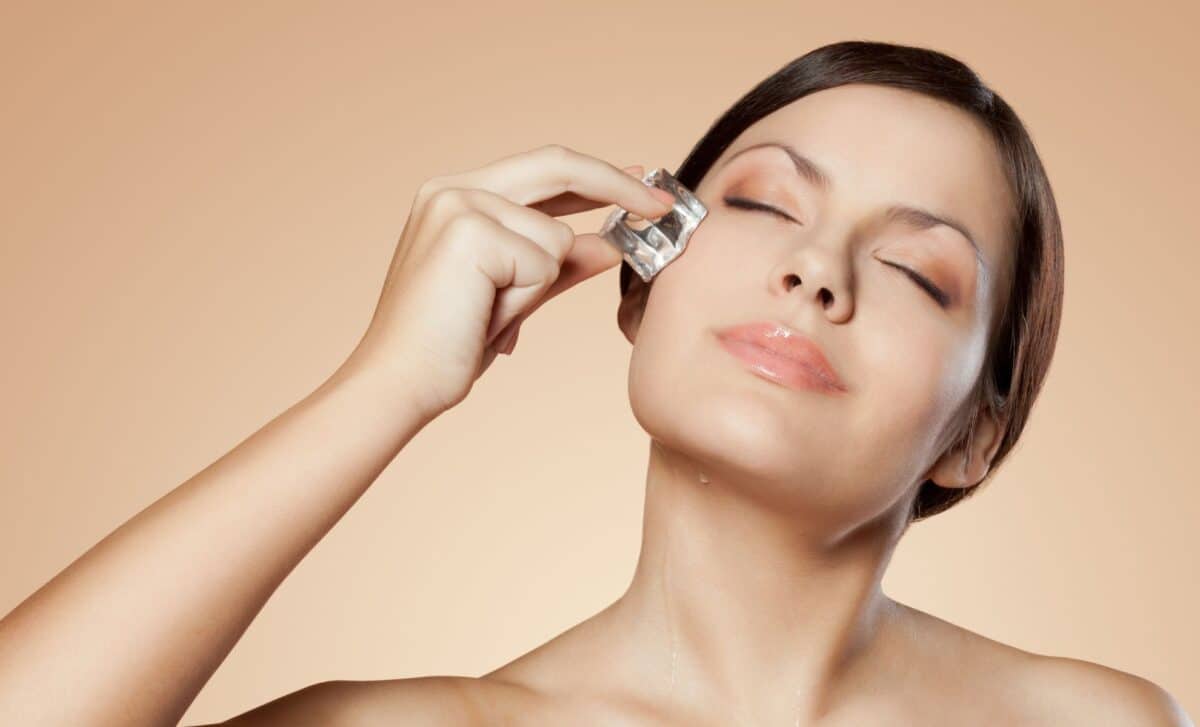Unlock the secret to glowy face with a simple technique that’s been used for centuries. Discover how to safely use ice on your face for a refreshed, radiant look. Dermatologists share their top tips for maximum benefits without the risks.
Why Ice Works for Your Ski
The cooling effect of ice offers several benefits for the skin. When applied, the cold constricts blood vessels, which helps reduce puffiness, especially around the eyes. This effect can make your face look less tired and more vibrant. Ice is also known to temporarily tighten the skin by reducing superficial inflammation and tightening pores. This can give you a smoother, more even appearance. For minor redness, irritation, or sunburn, the cold can soothe and calm the skin, providing immediate relief, once the skin warms up after icing, a rush of blood flow occurs, giving the skin a natural, healthy flush. These benefits, while temporary, are ideal for moments when you want your skin to look fresh and revived, especially before an event or as part of a cooling routine.
Safe Techniques for Icing Your Face
While the benefits of ice are clear, it’s crucial to apply it correctly to avoid damaging your skin. Dr. Aanchal Panth stresses that ice should never be applied directly to the skin. Direct contact can cause ice burns or microdamage to the delicate skin barrier. Instead, wrap the ice in a clean cloth or soft muslin cloth before applying it to your face. This creates a protective layer between the cold and your skin, preventing frostbite and irritation.
Dr. Panth recommends applying the ice for short durations of 1 to 2 minutes at a time. Focus on areas that typically show puffiness, such as under the eyes, the cheeks, and the jawline. It’s essential not to rub the ice aggressively on the skin. Instead, gently press or glide the wrapped ice over your skin without applying too much pressure. Make sure your face is clean before icing, as this will prevent dirt or bacteria from being trapped in your pores. After icing, always follow up with a gentle moisturizer or serum to lock in moisture and protect your skin.
Frequency and Precautions for Sensitive Skin
While icing can be done daily, Dr. Panth advises limiting the practice to 2–3 times a week for sensitive skin. Overuse of ice can lead to excessive dryness, redness, or irritation, especially for people with more delicate skin. For special occasions, a quick ice session just before applying makeup can make the skin appear smoother and more refreshed, but moderation is key.
There are certain skin conditions where icing may not be advisable. People with rosacea, for example, should avoid using ice, as the cold can trigger flare ups, worsening redness and irritation. Similarly, individuals with broken capillaries should be cautious, as ice can make these small, damaged blood vessels more noticeable. Those with extremely dry skin should also be careful, as the cold can strip the skin of its natural oils, further exacerbating dryness and irritation. Cold urticaria, a rare allergic reaction to cold temperatures, can also be triggered by ice, causing hives or swelling on the skin. If you experience any unusual symptoms such as persistent redness, stinging, or numbness after icing, Dr. Panth recommends stopping immediately and consulting a dermatologist.
DIY Ice Variations for Added Skincare Benefits
For an extra boost, you can enhance the effects of ice by freezing natural liquids. Instead of using plain water ice cubes, try freezing green tea, cucumber juice, aloe vera, or rose water. These variations provide added skincare benefits while maintaining the cooling sensation. Green tea ice cubes are rich in antioxidants that help soothe the face, while cucumber juice offers refreshing hydration. Aloe vera ice cubes are cooling and anti-inflammatory, making them perfect for irritated skin, and rose water ice cubes provide a gentle toning effect.
Why Ice Works for Your Skin
The cooling effect of ice offers several benefits for the face. When applied, the cold constricts blood vessels, which helps reduce puffiness, especially around the eyes. This effect can make your face look less tired and more vibrant. Ice is also known to temporarily tighten the skin by reducing superficial inflammation and tightening pores. This can give you a smoother, more even appearance. For minor redness, irritation, or sunburn, the cold can soothe and calm the skin, providing immediate relief. Furthermore, once the skin warms up after icing, a rush of blood flow occurs, giving the skin a natural, healthy flush. These benefits, while temporary, are ideal for moments when you want your skin to look fresh and revived, especially before an event or as part of a cooling routine.
Summer’s Weirdest Cooling Hack? Aluminum Foil Balls in the Freezer
Safe Techniques for Icing Your Face
While the benefits of ice are clear, it’s crucial to apply it correctly to avoid damaging your skin. Dr. Aanchal Panth stresses that ice should never be applied directly to the skin. Direct contact can cause ice burns or microdamage to the delicate skin barrier. Instead, wrap the ice in a clean cloth or soft muslin cloth before applying it to your face. This creates a protective layer between the cold and your skin, preventing frostbite and irritation.
Dr. Panth recommends applying the ice for short durations of 1 to 2 minutes at a time. Focus on areas that typically show puffiness, such as under the eyes, the cheeks, and the jawline. It’s essential not to rub the ice aggressively on the skin. Instead, gently press or glide the wrapped ice over your skin without applying too much pressure. Make sure your face is clean before icing, as this will prevent dirt or bacteria from being trapped in your pores. After icing, always follow up with a gentle moisturizer or serum to lock in moisture and protect your skin.
Frequency and Precautions for Sensitive Skin
While icing can be done daily, Dr. Panth advises limiting the practice to 2–3 times a week for sensitive tissue. Overuse of ice can lead to excessive dryness, redness, or irritation, especially for people with more delicate skin. For special occasions, a quick ice session just before applying makeup can make the skin appear smoother and more refreshed, but moderation is key.
There are certain skin conditions where icing may not be advisable. People with rosacea, for example, should avoid using ice, as the cold can trigger flare-ups, worsening redness and irritation. Similarly, individuals with broken capillaries should be cautious, as ice can make these small, damaged blood vessels more noticeable. Those with extremely dry skin should also be careful, as the cold can strip the skin of its natural oils, further exacerbating dryness and irritation. Cold urticaria, a rare allergic reaction to cold temperatures, can also be triggered by ice, causing hives or swelling on the skin. If you experience any unusual symptoms such as persistent redness, stinging, or numbness after icing, Dr. Panth recommends stopping immediately and consulting a dermatologist.
DIY Ice Variations for Added Skincare Benefits
For an extra boost, you can enhance the effects of ice by freezing natural liquids. Instead of using plain water ice cubes, try freezing green tea, cucumber juice, aloe vera, or rose water. These variations provide added skincare benefits while maintaining the cooling sensation. Green tea ice cubes are rich in antioxidants that help soothe the skin, while cucumber juice offers refreshing hydration. Aloe vera ice cubes are cooling and anti-inflammatory, making them perfect for irritated skin, and rose water ice cubes provide a gentle toning effect. After icing, gently pat your face dry and apply your favorite moisturizer, serum, or facial oil to nourish and hydrate your skin. Avoid using harsh exfoliants or active ingredients right after, as your skin may be more sensitive following the cold therapy.







